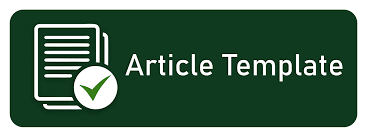Pengembangan Instrumen Diagnostik Two Tier Multiple Choice Untuk Mengidentifikasi Miskonsepsi Pada Materi Senyawa Hidrokarbon
DOI:
https://doi.org/10.30862/accej.v7i2.762Keywords:
hidrokarbon, two tier multiple choice, senyawaAbstract
Tes diagnostik two tier multiple choice ialah pengujian diagnostik melalui angket pilihan ganda dilengkapi pilihan rasionalisasi. Tujuannya untuk menganalisa prosedur pengembangan angket diagnostik two tier multiple choice untuk mengidentifikasi kegagalan dalam memahami pada materi senyawa hidrokarbon serta untuk mengetahui kelayakan yang ditinjau mulai indikator kevalidan, reliabilitas, kepraktisan, serta keefektifan. Penelitian mengambil jenis R&D dengan memakai model 4D. Subjeknya ialah siswa siswi kelas XI IPA SMA Negeri 1 Tanah Miring berjumlah 10 siswa sebagai uji coba skala kecil dan 34 orang sebagai uji coba skala besar. Instrumen yang dipakai selama mengumpulkan data ialah angket, wawancara serta pengujian diagnostik two tier multiple choice yang sudah tervalidasi 2 validator. Hasilnya yaitu instrumen diagnostik two tier multiple choice meliputi kriteria valid, reliabel, praktis dan efektif. Hasil validasi intrumen ditemui persentase sejumlah 86% berkategori sangat valid. Hasil reliabilitas instrumen sebesar 0,941 pada tier 1 dan 0,952 di tier 2 berkategori sangat tinggi. Hasil uji kepraktisan instrumen pada 2 praktisi diperoleh nilai 96% dengan kategori sangat praktis. Keefektifan instrumen two tier multiple choice mengacu keberhasilan intrumen selama mendeteksi miskonsepsi didapatkan data sebesar 41% dengan kategori miskonsepsi sedang. Sehingga dapat disimpulkan instrumen two tier multiple choice untuk menganalisa miskonsepsi untuk materi senyawa hidrokarbon sudah mencapai dinyatakan valid, reliabel, praktis, serta efektif sehingga barang pantas dioptimalkan guna alat evaluasi proses belajar kimia.
References
Belachew, W. (2020). Nudging Collage Pre-service Teachers toward the Desired Path in Isomerism Concept of Aliphatic Hydrocarbons through the use of Conceptual Change Texts. Journal of Mathematics, Science and Thecnology Education, 16(1), 1-16.
Dilapanga, H. ., Paputungan, M., Tangio, J. ., & Kilo, J. L. (2022). Identifikasi Pemahaman Konsep Siswa pada Materi Hidrokarbon. Journal of Educational Chemistry, 4(1), 26–30.
Fantiani, C., Afgani, M. W., & Astuti, T. (2023). Analisis Miskonsepsi Siswa Berbantuan Certainly of Response Index (CRI) pada Materi Pembelajaran Laju dan Orde Reaksi. Jurnal Inovasi Pendidikan Kimia, 17(1), 36-40.
Hidayat, F. A., Irianti, M., & Fathurrahman, F. (2020). Analisis Miskonsepsi Siswa Dan Faktor Penyebabnya Pada Pembelajaran Kimia Di Kabupaten Sorong. Jurnal Inovasi Pembelajaran IPA, 1(1), 1–8.
Laksono, P. . (2019). Pengembangan Dan Penggunaan Instrumen Two-Tier Multiple Choice Pada Materi Termokimia Untuk Mengukur Kemampuan Berpikir Kritis. Orbital: Jurnal Pendidikan Kimia, 2(2), 80–92.
Mutmainna, D., Mania, S., & Sriyanti, A. (2018). Pengembangan Instrumen Tes Diagnostik Pilihan Ganda Dua tingkat Untuk Mengidentifikasi Pemahaman Konsep Matematika. Jurnal Matematika Dan Pembelajaran, 6(1), 56–59.
Pongkendek, J. J., & Kristyasari, M. L. (2022). Penggunaan Two Tier Multiple Choice Untuk Analisis Miskonsepsi Mahasiswa. QUANTUM: Jurnal Inovasi Pendidikan Sains, 13(1), 131–139.
Qodriyah, N. R. L., Rokhim, D. A., Widarti, H. R., & Habiddin, H. (2020). Identifikasi Miskonsepsi Siswa Kelas Xi Sma Negeri 4 Malang Pada Materi Hidrokarbon Menggunakan Instrumen Diagnostik Three Tier. Jurnal Inovasi Pendidikan Kimia, 14(2), 2642–2651.
Rico, A. end, & Fitriza, Z. (2021). Deskripsi Miskonsepsi Siswa pada Materi Senyawa Hidrokarbon. Jurnal Ilmu Pendidikan, 3(4), 1495–1502.
Septiani, A. ., & Sjaifuddin, S. (2022). Literasi Sains Siswa Kelas VII Pada Tema Hujan Asam. BIODIK: Jurnal Ilmiah, 08(1), 167–174.
Sihaloho, M., Hadis, S. S., Kilo, A. K., & Kilo, L. (2021). Diagnosa Miskonsepsi Siswa SMA Negeri 1 Telaga Gorontalo pada Materi Termokimia. Journal of Educational Chemistry, 3(1), 7–13.
Sumanik, N. B., Nurvitasari, E., & Siregar, L. F. (2021). Flip Book Maker Based Water Chemistry E-module Development as a Distance Learning Alternative. Proceedings of the International Joined Conference on Social Science, 603, 448–452.
Sumanik, N. B., Parlindungan, J. Y., Andari, G., & Siregar, L. F. (2021). Analisis Persepsi Mahasiswa Terhadap Penggunaan Quizizz Sebagai Evaluasi Hasil Belajar disertai Asessment Online. Musamus Journal of Science Education, 4(1), 014–021.
Sumanik, N. B., Siregar, L. F., Pasaribu, Y. P., & Buyang, Y. (2023). Literature Study: Liveworksheet as a Science Learning Media Electronic Student Worksheet in The Merdeka Curriculum. Technium Social Sciences Journal, 49, 374–382.
Vellayati, S., Nurmaliah, C., & Saidi, N. (2020). Identifikasi Tingkat Pemahaman Konsep Siswa Menggunakan tes Diagnostik Three-tier Multiple Choice pada materi hidrokarbon. Jurnal Pendidikan Sains Indonesia, 8(1), 128-140.
Downloads
Published
How to Cite
Issue
Section
License
Copyright (c) 2024 Meylisa Liku Arrang, Jesi Jecsen Pongkendek, Novike Bela Sumanik

This work is licensed under a Creative Commons Attribution-NoDerivatives 4.0 International License.
License and Copyright Agreement
In submitting the manuscript to the journal, the authors certify that:
- They are authorized by their co-authors to enter into these arrangements.
- The work described has not been formally published before, except in the form of an abstract or as part of a published lecture, review, thesis, or overlay journal. Please also carefully read Arfak Chem: Chemistry Education Journal Posting Your Article Policy at http://journalfkipunipa.org/index.php/accej/about
- That it is not under consideration for publication elsewhere,
- That its publication has been approved by all the author(s) and by the responsible authorities – tacitly or explicitly – of the institutes where the work has been carried out.
- They secure the right to reproduce any material that has already been published or copyrighted elsewhere.
- They agree to the following license and copyright agreement.
Copyright
Authors who publish with Arfak Chem: Chemistry Education Journal agree to the following terms:
- Authors retain copyright and grant the journal right of first publication with the work simultaneously licensed under a Creative Commons Attribution License (CC BY-ND 4.0) that allows others to share the work with an acknowledgment of the work's authorship and initial publication in this journal.
- Authors are able to enter into separate, additional contractual arrangements for the non-exclusive distribution of the journal's published version of the work (e.g., post it to an institutional repository or publish it in a book), with an acknowledgment of its initial publication in this journal.
- Authors are permitted and encouraged to post their work online (e.g., in institutional repositories or on their website) prior to and during the submission process, as it can lead to productive exchanges, as well as earlier and greater citation of published work.









